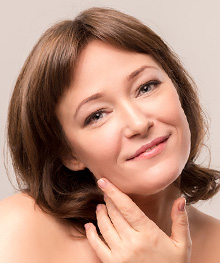Botox Treatment
 Botox is a neuromuscular blocking agent which when injected into the facial muscles prevents movement of the muscles for approximately four months. This results in the temporary nonsurgical elimination of facial wrinkling.
Botox is a neuromuscular blocking agent which when injected into the facial muscles prevents movement of the muscles for approximately four months. This results in the temporary nonsurgical elimination of facial wrinkling.
Which Lines Respond Best to Botox?
The actively moving facial lines of the forehead, the frown lines between the eyes and the crow’s feet lines adjacent to the eyes respond best to Botox.
These prominent lines are sometimes interpreted as anger, anxiety, fear, fatigue, melancholy and aging.
Botox will not reverse sagging skin. Botox does not improve wrinkling caused by sun damage or aging.
How Long Does Botox Last?
Muscle movement will cease two weeks following the injection of Botox. The lack of movement will last approximately four months.
How Is Botox Delivered?
Dr. Oshman injects Botox directly into the muscle in small amounts to prevent side effects. No anesthesia is required.
The procedure is performed in the Westport and New Canaan offices. An ice pack is applied to the area following the injection to prevent bruising.
Normal activities may be resumed following the procedure including driving a car.
Are Botox Treatments Safe?
There is little information on the effects of long term treatment with Botox. There has not been a confirmed serious case of toxin effect away from the injection site when Botox is used at the recommended dose.
Botox should not be used during pregnancy or in anyone with a neuromuscular disease or known allergic reactions to human albumin or to any botulinum toxin product.
Anyone with significant scarring, thick leathery skin or very lax skin may not be a good candidate for Botox injections.
What You Should Do After a Botox Treatment
- Do not message the injection area.
- Stay upright for 3 to 4 hours.
- Take 2 Tylenol every 3-4 hours for headache or flu like symptoms.
Possible Side Effects
Common to all injected areas
- Bruising
- Headache
- Flu like symptoms
- Numbness
Terms to Know
Glabellar Frown Lines
(between the eyes)
- Upper eyelid drooping (ptosis) – begins in 1-2 weeks and lasts about 4 weeks
- Blurred vision, double vision or decreased eyesight
- Swelling of the eyelids
- Dry eyes
Horizontal Forehead Lines
- Drooping brow (ptosis)
- Asymmetric brow height
- Lack of expressivity
- Brow heaviness
Crow’s Feet
- Lower eyelid drooping (ptosis)
- Fat herniation of the lower lid
Should you experience any loss of strength or general muscle weakness, vision problems or dizziness within hours or weeks of Botox injections do not drive a car, operate machinery or do other dangerous activities. Immediately inform Dr. Oshman of any of these changes.
Interested in Botox? Call Robin Gail Oshman M.D., Ph.D. in
Westport and New Canaan, CT at 203-454-0743 to schedule an appointment for a free consultation today.